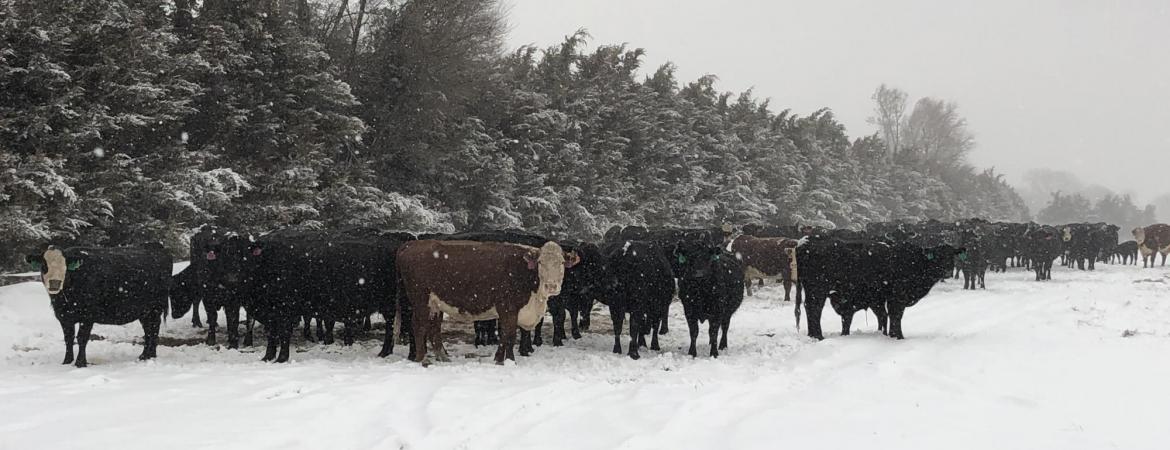Conservation Tree Windbreaks Provide Critical Protection for Cattle During Harsh Winter
Conservation Tree Windbreaks Provide Critical Protection for Cattle During Harsh Winter
For Immediate Release
Wednesday, March 27, 2019
Contact: Dustin Wilcox, Nebraska Association of Resources Districts Liaison
Phone: (402) 471-7673 Cell: (402) 533-9530
Email: dwilcox [at] nrdnet.org
Conservation Tree Windbreaks Provide Critical Protection for Cattle During Harsh Winter
(Nebraska) Windbreaks have played an important role in the protection of livestock as Nebraska’s farmers and ranchers have worked to protect their cattle during a remarkably long and harsh winter. Since 1972 Nebraska’s Natural Resources Districts (NRDs) have worked with Nebraska landowners to plant over 96 million trees and shrubs. Many of these plantings are multi-purpose windbreaks that shade and shelter homes, reduce soil erosion, protect crops and provide food and cover for wildlife. But this winter, it was the protection windbreaks provided cattle that proved most beneficial to Nebraska farmers and ranchers.
Windbreaks provide benefits to feedlots, pastures, and calving areas by reducing wind speeds and providing the animals a reprieve from the harsh winter elements. Protecting the animals from the elements not only reduces stress and mortality, it reduces feed requirements and saves the producer money.
“The red cedar windbreaks on our ranch were critical in protecting our cows this winter” said, Justin Hammond, Nebraska Rancher and Middle Niobrara NRD board member. “Without the windbreak protection, we’d have lost a large portion of our herd.”
NRD foresters say now is the time to rehab an existing windbreak or design plans for the planting of a new one. According to the Nebraska Association of Resources Districts (NARD), local NRDs have ordered nearly 400,000 trees and shrubs for landowners to plant this spring.
“Our NRD Tree Program offers landowners an inexpensive way to protect their property,” Mike Murphy, General Manager Middle Niobrara NRD said. “NRD staff and foresters work with landowners to select the right trees for the property, design the space and we can even plant them for you.”
For around a dollar a tree, conservation trees shade and shelter homes, reducing energy costs, protect and increase crop yields, reduce soil erosion from wind and water, improve water quality, control snow and preserve winter moisture, protect livestock, provide food and cover for wildlife, control noise, capture atmospheric carbon, raise property values, and add beauty to our landscape.
Each of the 23 NRDs administer their own conservation tree program. Tree and shrub options may vary from district to district depending on what grows well in different areas of the state.
“The local NRDs really work with landowners to determine what species best fit a landowners need,” Murphy said. “In some areas it may be eastern red cedar that offers the best protection, and in other areas it may be a combination of species.”
Trees arrive in early spring and many NRD Conservation Tree Program order deadlines are quickly approaching. Contact your local Natural Resources District to complete your tree order. You can visit www.nrdnet.org to locate your local NRD.
###
The Nebraska Association of Resources Districts (NARD), the trade association for Nebraska's 23 natural resources
districts, works with individual NRDs to protect lives, protect property, and protect the future of Nebraska’s natural
resources. These districts are unique to Nebraska. NRD’s are local government entities with broad responsibilities
to protect our natural resources. Major Nebraska river basins form the boundaries of the 23 NRDs, enabling
districts to respond best to local conservation and resource management needs. To learn more about Nebraska’s
NRDs visit www.nrdnet.org. Or you can head to the Natural Resources Districts’ Facebook page at
www.facebook.com or follow NARD’s Twitter page at www.twitter.com @nebnrd. NARD is located at 601 S. 12th
St. Suite 201, Lincoln, Nebraska 68508. Email NARD at nard [at] nrdnet.org or call NARD at (402) 471-7670.
| Attachment | Size |
|---|---|
| 284.24 KB |

